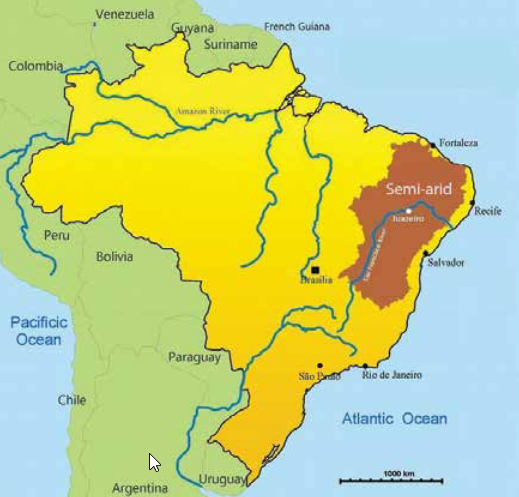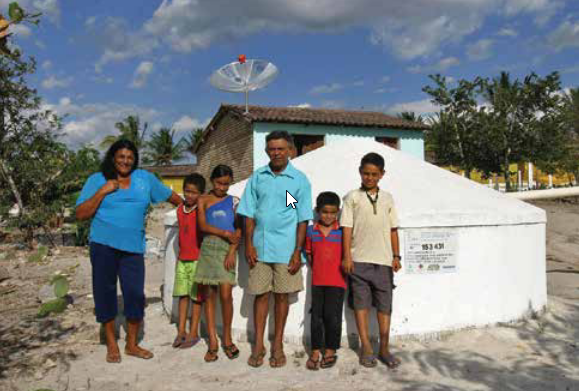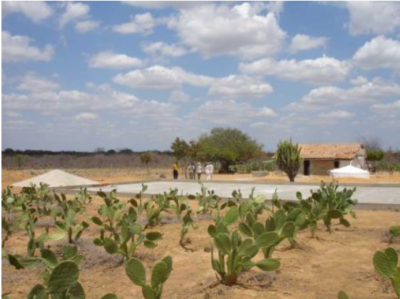Make Your Experiences Count. They Can Change the World.
LET’S BRING ALL OF OUR KNOWLEDGE AND EXPERIENCES TOGETHER.
TOGETHER WE KNOW MORE. TOGETHER WE ACHIEVE MORE. TOGETHER WE DO BETTER.
LET’S BRING ALL OF OUR KNOWLEDGE AND EXPERIENCES TOGETHER.
TOGETHER WE KNOW MORE. TOGETHER WE ACHIEVE MORE. TOGETHER WE DO BETTER.
Published: October 14, 2020
Hans Gnadlinger has been working with HORIZONT3000 for over 20 years as a TA in Brazil. At the moment he is already retired, but he keeps collaborating with national and international networks of rainwater harvesting experts.
In our projects at HORIZONT3000 rainwater harvesting is a very current topic, which is why we ran our lastest KNOWLYMPICS under the title of Rainwater Management.
I’m very glad to have gotten the chance to have this conversation with Hans Gnadlinger – an experienced expert in water management – specifically rainwater management. Please watch the video below or keep reading to find out what he had to tell us about it.
Dear Hans, first of all I would like to thank you for joining me today and for sharing your experiences with us. I really appreciate it! I would like to start off with the following question: In which context and when does it actually make sense to apply rainwater harvesting methods and what can rainwater be used for?
It’s a great pleasure for me to be able to share my experience with you. My experience stems from Brazil, not from the Amazon region, but from the semiarid Brazil that – in terms of climate – is comparable to Sub-Saharan Africa. The dry season here lasts about eight months, so there’s only four months of rainfall – and on top of that during those four months the rainfall is irregular. That means: Yes, water is a problem.
We do think though, and we’ve made the experience too, that there is a solution. It is not about trusting in big wells or river diversions, since these approaches always result in centralisation, where people have to overcome smaller or larger distances to get to the well.
It’s about being able to access water everywhere and rain falls everywhere. That’s why we see the solution in catching the rain for the dry season. In the semiarid climate this solution works. Thus, I think it would be a possibility for other regions even continents as well. For instance, before we started the rainwater project women from participating villages had to walk far distances to get drinking water every day. Now, they have access to water close to their homes, which gives them time for other activities – for instance to take part in small businesses, take care of their family and so on. Consequently the effects are noticeable in every aspect of life.
We have already reached the goal of establishing one million cisterns for drinking water, which means that five million people have access to drinking water now. Of course, how well this solution works always depends on the context. We can, however, recommend it for other countries as well.

There are quite a lot of agricultural projects we collaborate with, where farmers live in semiarid climate zones similar to the one you live in. From these projects we sometimes get proposals for wells – farmers and communities are still focused on building wells and accessing groundwater. According to your experience, what advantages and disadvantages does rainwater harvesting come along with compared to the traditional approach of wells. You’ve already mentioned the aspect of centralisation and that people have to walk long distances. I am interested in knowing, whether there is also an ecological aspect to it as well.
In order to complete the answer to the first question, I would like to highlight that there are water cisterns being constructed even in humid areas of Brazil now. This is due to the fact that water is becoming ever more scarce. Climate change is causing some areas to get drier and people can’t keep depending on irregular rainfalls.
In order to answer your question concerning wells: Wells can definitely be a very good solution. It always, however, depends on the subsoil. If the subsoil is crystalline, there is no continuous water in the subsoil. The water also gets in the cracks of the granite. Those cracks hold very little space for water and therefore the quality is not very good either.
If the subsoil contains sandstone, it’s a lot easier to get good quality water, as there is usually more water there. Limestone is not great either, because of pollution problems. So even though people as well as politicians tend to first think of drilling holes and wells, we think that rainwater harvesting is simply a more secure solution, because it doesn’t depend on aspects like subsoil constitution. Also because the water is stored in cisterns near their houses. Another advantage is that people can actually build and fix the cisterns themselves with a brick layer from the community. With wells and pumps the communities many times can’t resolve occurring problems, which often leads to them waiting for a company or for politicians, who will only attend to the problem when the next elections are coming up. This is what happens in Brazil all the time.

So the two big advantages of rainwater harvesting that you mention are availability and maintenance. Rainwater is everywhere and the cisterns are built from material that people themselves can manage. I would like to talk a bit about the different approaches to rainwater catchment and management. What differentiates the approach you and IRPAA, the Partner Organisation, are working with and promoting from others.
For us rainwater management is part of a bigger idea: the possibility of living in harmony with the semiarid climate. One crucial aspect is water. Another one, however, is access to land and the know-how to be able to live off the land. That’s the reason why our programme also involves education, women empowerment and other aspects relevant to the community’s development.
I understand that you are viewing the concept from a systematic point of view. With the rainwater harvesting approach you are trying to find solutions that meet the system’s needs – and therefore the people’s way of living – in order to work in harmony in a semiarid climate. In the Experience Documents uploaded on our platform you talk about a five step approach, which does not only include drinking water and agriculture, but other aspects that are focused on the community as well. I guess that is probably why you call it an integrated approach for rainwater management and use.
The five steps you describe are drinking water for communities, for agriculture and livestock, for emergency situations and for the environment. All of these need some source of water and each of them has a different rainwater catchment method as far as I understood. Is that correct?
Yes, correct! So far, I have only referred to the drinking water aspect in our conversation, since this was the most fundamental point for the people. However, rainwater can also be used for agriculture and livestock. In our region we mostly hold sheep and goats, since they can live with less water and inferior quality.
Another use of rainwater is agriculture – above all for vegetable gardens, which are located close to the homes as well. Here we apply bigger cisterns: our drinking water cisterns can hold 16.000 liters compared to our agriculture cisterns, which can hold up to 52.000 liters of water. The water is used only for supplementary irrigation, which means they only use it when they need it.
Contour farming is another approach applied: It’s an approach that catches the rainwater on the ground so that other plants can be cultivated, as for instance sorghum. We have made the experience that sorghum is better than corn, because it is more adapted to the dry climate.
What I am trying to get across here is: The context matters. It’s important not only to consider irrigation, but also the type of crop as well as the type of animals you work with. Goats and sheep for instance are a strategic choice, because, as mentioned before, they need less water than cows.

You’ve presented the reasons for you and IRPAA choosing this integrated approach that considers different types of needs for water. My next question is about the three most important success factors regarding sustainable rainwater management. What do people applying the approach need to think of in order to make it sustainable and successful?
First of all, it is necessary to highlight that simple technologies work. We call them social technologies. Social technologies refer to technologies that the people themselves can manage. As explained earlier, the cisterns for instance are built from material that is available to the communities and the brick layers are from the communities as well. So that is what differentiates them for instance from PVC Cisterns, as they come from outside, the money for them does not stay in the community. Also they can’t be repaired as easily by the community.
This leads me to the second crucial point: the organisation of people. People must be independent from outside, from donour organisations, from politicians. In the scope of the 1.000.000 cistern project, we have observed that rainwater has helped to better organise the people. People got used to have to come together and discuss topics like hygiene, accessibility, maintenance etc.
The third fundmental aspect to make it work is the political will. The municipality, the state or the country need to approve the demand of solving the problem. Right now, we have a government that does not seem very interested in Brazil’s people. The administration has cut fundings for this programme and we still need 300.000 cisterns to cover all families and households in the semiarid region. We hope that this is a intermediary situation, since in order to be really successful political support is essential too.
Hans, thank you very much for mentioning those three very crucial points that cover the political to the organisational to the individual level. At HORIZONT3000 we have another project that promotes „farmers in the driving seat“. I generally like the idea of „people in the driving seat“ – above all regarding water, we have to find solutions that are valuable for the long run. Whoever is interested in finding more information on the topic, please visit IRPAA’s website, which offers a wide range of info in English, Portuguese, Spanish and German.
Also Hans is very well connected nationally and internationally with other institutes and organisations working with rainwater management. He just told me that at the moment there is a virtual symposium in Stockholm on the topic. Whoever wants to get in touch and learn more on rainwater management, there is a lot of experiences and literature on the topic and I am always happy to help, if you wish to get in touch with me. Feel free to get in touch with Hans in Brazil as well. Is there anything you would like to add, Hans?
Yes, I would like to emphasize the aspect of people getting organised themselves in form of an Association. We have established a network – the Semiarid Network of Grassroots People Organisations – and there are 1000, more than 1000 organisations participating. We have a common strong voice together so that we can defend our agendas in front of the government for instance as well.
And finally, I wish all of you the best, also to resolve the water problem in your countries and regions. I know it’s not easy, but it’s possible! And it pays off: healthier people, happier people – here in Brazil, in the semiarid region and also in other parts of the world.